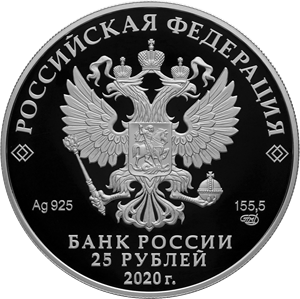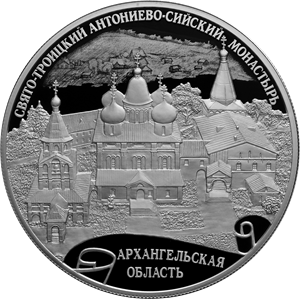Antonievo-Siysky Monastery of the Holy Trinity, Arkhangelsk Region
Obverse
the mirror field of the disc bears a relief image of the National Coat of Arms of the Russian Federation, over it along the rim there is the semicircular inscription "РОССИЙСКАЯ ФЕДЕРАЦИЯ" (RUSSIAN FEDERATION) framed on both sides by doubled rhombuses, below under the coat of arms there are indications of the precious metal and its fineness on the left and the fine metal content and the mint trade mark on the right, at the bottom in the centre, in three lines, there is an inscription "БАНК РОССИИ" (BANK OF RUSSIA), the denomination of the coin "25 РУБЛЕЙ" (25 RUBLES), and the year of issue "2020 г." (2020).
Reverse
the mirror field of the disc bears a relief image of the Antonievo-Siysky Monastery of the Holy Trinity and the inscriptions ‘СВЯТО-ТРОИЦКИЙ АНТОНИЕВО-СИЙСКИЙ МОНАСТЫРЬ’ (ANTONIEVO-SIYSKY MONASTERY OF THE HOLY TRINITY) at the top along the rim and ‘АРХАНГЕЛЬСКАЯ ОБЛАСТЬ’ (ARKHANGELSK REGION) at the bottom in two lines.
Authors
The artists: E.V. Kramskaya (obverse), A.V. Gnidin (reverse).
The sculptors: A.A. Dolgopolova (obverse), A.V. Gnidin (reverse).
Mint: Saint Petersburg Mint.
The edge: 252 corrugations.
Discover more
The Holy Trinity Antonievo-Siysky Monastery is an Orthodox monastery that is located in the Kholmogorsky District of Arkhangelsk Region. It stands on a peninsula cutting into Lake Bolshoye Mikhailovskoye, one of the lakes that the Siya river (a tributary of the Northern Dvina) flows through. The monastery was founded in 1520 by Saint Anthony of Siya, whose remains are currently its main holy relic.
The Church of the Holy Trinity, which gave the monastery its name, was built in 1606. The surrounding architectural complex did not form in its entirety until the late 17th century.
From the 16th to 18th centuries, it was one of the major spiritual and cultural landmarks of the Russian North. The monastery possessed a vast library of over twenty thousand volumes, including several unique manuscripts. It also had its own icon workshop. Over the course of several centuries, the monastery amassed a priceless collection of artefacts, including jewellery. They were mostly brought there as gifts and donations and were a vital part of Russia’s history and culture.
Feodor Nikitich Romanov, father of the first Romanov Tsar, Mikhail Feodorovich, was exiled there from 1601 to 1605, having been ordered by Boris Godunov to take monastic vows under the name Filaret (eventually, he would turn his sentence to his advantage, becoming the Patriarch of Moscow and all Russia).
During the latter half of the 18th century, when the monasteries’ holdings were confiscated for the Tsar’s treasury, the Siysky Monastery entered an era of decline. It was shut down in 1923, to be restored only after the return of the Russian Orthodox Church in 1992. Today, the monastery has gone back to providing religious services.


